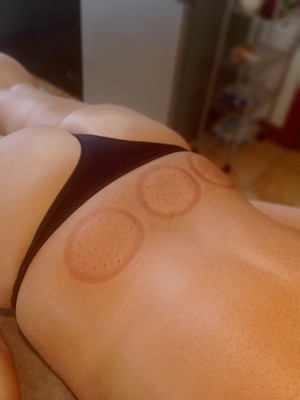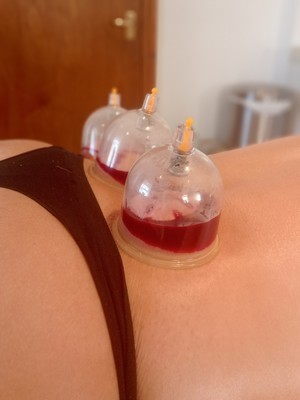Cupping Therapy for Fibromyalgia Pain, Chronic Fatigue and Anxiety

Cupping Therapy for Fibromyalgia is part of Traditional Chinese Medicine and can reduce Fibromyalgia symptoms of chronic pain, chronic fatigue and anxiety. Cupping Therapy for Fibromyalgia also known as Cupping massage is an integral part of Traditional Chinese Medicine. Cupping massage practitioners place warmed or heated glass, plastic or silicone cups onto the skin and a vacuum is formed allowing the skin to be lifted from the fascia tissues. Cupping therapy is traditionally used for muscle and joint pain, skin conditions and respiratory problems. It is also helps with anxiety and depression.
People with Fibromyalgia have very painful fascia, connective tissues, tight muscle adhesions and restricted blood, lymph, oxygen and Qi flow. People with Fibromyalgia also have a lot of Qi stagnation caused by chronic stress, lack of good sleep, depression and anxiety.
It is said that Cupping massage removes stagnation in the body and opens the energy pathways or meridians so that Qi can flow freely. The aim of Cupping therapy is to release toxins, ease painful muscle and fascia adhesions and to facilitate Qi, lymph and blood to flow which in turn will ease pain, reduce fatigue and eliminate depression and anxiety.
Cupping Therapy for Fibromyalgia can Reduce Fibromyalgia Symptoms
There have been studies on the effects of cupping on people with Fibromyalgia including Medicinal Cupping Therapy in 30 patients with Fibromyalgia.
The aim of the study was to evaluate the therapeutic effect of traditional medicinal cupping for treatment of Fibromyalgia.
The study concluded that “Medicinal cupping therapy was associated with a reduction in Fibromyalgia symptoms for both pain ratings and number of tender points.”
Types of Cupping Therapy for Fibromyalgia
There are two types of Cupping therapy techniques used by Traditional Chinese Medicine practitioners or other therapists. Basically one type of Cupping therapy glides, slides or massages the body, whereas the other type of Cupping therapy is stationary.
You may have seen from the Olympics that some swimmers had circular red markings on their backs. This is the result of stationary fire Cupping therapy. Sports people and some notable celebrities including Victoria Beckham, Gwyneth Paltrow and Jennifer Aniston have all sported the red marks from fire Cupping therapy.
With fire Cupping therapy or other forms of stationary Cupping therapy the cups are left in place for around 15 minutes. They are normally placed on the neck, back and shoulders. The skin will redden or bruise and may feel sore and the more congested the blood flow is, the deeper the colour will be and the longer the redness or bruising will remain. Sometimes the redness can last from a couple of hours to a couple of days.
The gliding or sliding method of Cupping therapy allows the therapist to move the vacuumed skin up or down the energy pathways or meridians or in areas that are painful. Oil is used to allow for smooth gliding.
I’ve had both methods used on me with fantastic results.
Read more about my experience of Cupping therapy for Fibromyalgia pain
and fatigue.
My Experience of Cupping Therapy for Fibromyalgia Pain and Fatigue
Being treated at first by Physiotherapists and then by Chinese medicine practitioners I can wholeheartedly recommend Cupping therapy for Fibromyalgia symptoms of pain, fatigue and depression. I’ve had Cupping therapy treatments virtually all over my body with sliding or gliding Cupping therapy techniques and the static stationary fire Cupping therapy methods.
I have to say, at my worst, when I could barely allow anyone to touch my extremely painful legs any form of massage or touching had me close to tears. But I gritted my teeth and allowed my Physiotherapist to use firm massage, Gua Sha scraping and Cupping therapy to smooth out and loosen the stuck and painful fascia throughout my body. Both my outer and inner legs and thighs were particularly painful. My male Physiotherapist was a former Premier League football Physiotherapist who said players would be in tears if he gave them the same painful treatment as I was undergoing. Gradually over time the results I felt just minutes after a session were amazing. All my aches and pains diminished and I felt lighter, slimmer and freer.
So enthused was I by the results of gliding Cupping therapy to release my painful and rigid fascia on my legs, arms and back, I bought my own set of cups. They come in a set of varying sizes and I used them all over my body where I could reach. My husband helped me with my back and shoulders. I even used the smaller ones on my face and neck. You need to use some form of oil to allow the cups to glide.
For Cupping therapy to be truly effective for Fibromyalgia symptoms, I would suggest a minimum of 5 treatments coupled with other forms of Traditional Chinese Medicine including daily
Gua Sha scraping,
Qigong, Tui Na massage and a good diet.
Wet Cupping Hijama

Athough
not from the Traditional Chinese Medicine
tradition I also had several Wet Cupping sessions or blood letting. I found it to be very effective.
Wet cupping, also known as hijama from Asian traditions, is an alternative medical practice that involves creating small incisions on the skin and then applying cups to create suction. The cups used in wet cupping are typically made of glass or bamboo.
The procedure begins with the therapist making small, superficial cuts on the skin using a sterilized scalpel or a specialized tool. The cups are then placed over the incisions, and a vacuum is created by either heating the cups with fire or using a mechanical suction pump.

The suction draws a small amount of blood from the incisions into the cups. After a few minutes, the cups are removed, and the therapist cleans and covers the incisions.
Proponents of wet cupping believe that it can help to remove harmful substances and toxins from the body, improve blood circulation, and promote healing. They suggest that wet cupping can be beneficial for a variety of conditions, such as chronic pain, inflammation, musculoskeletal disorders, and certain skin conditions.
More on Cupping Therapy for Fibromyalgia
Cupping therapy is a traditional practice that involves creating suction on the skin using cups, which are typically made of glass, bamboo, or plastic. While cupping therapy is often used for various purposes, including pain relief, its specific benefits for Fibromyalgia are not well-established through scientific research. However, proponents of cupping therapy suggest a few potential benefits that may apply to Fibromyalgia patients:
1. Pain reduction: Cupping therapy is believed to help relieve pain by improving blood circulation, loosening muscles, and promoting the release of endorphins, which are natural pain-relieving chemicals in the body. Some Fibromyalgia patients have reported temporary pain relief after cupping sessions, although the evidence is largely anecdotal.
2. Muscle relaxation: Fibromyalgia is often associated with muscle stiffness and tension. Cupping therapy aims to relax the muscles and alleviate tightness by creating suction and drawing blood flow to the treated areas. This may potentially help reduce muscle soreness and improve range of motion.
3. Stress reduction: Fibromyalgia patients commonly experience heightened stress levels, which can exacerbate their symptoms. Cupping therapy is thought to have a relaxing effect on the nervous system, promoting a sense of calmness and reducing stress. This may indirectly benefit Fibromyalgia patients by improving their overall well-being.
4. Improved sleep quality: Many Fibromyalgia patients struggle with sleep disturbances and insomnia. Cupping therapy's potential to induce relaxation and reduce pain may contribute to improved sleep quality and duration. However, more research is needed to validate this claim.